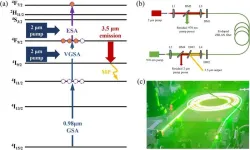(Press-News.org) Beneath Svalbard’s permafrost, millions of cubic meters of methane are trapped — and scientists have now learned that it can migrate beneath the cold seal of the permafrost and escape. A large-scale escape could create a cycle of warming that would send methane emissions skyrocketing: warming thaws the permafrost, causing more gas to escape, allowing more permafrost to thaw and more gas to be released. Because Svalbard’s geological and glacial history is very similar to the rest of the Arctic region, these migrating deposits of methane are likely to be present elsewhere in the Arctic.
“Methane is a potent greenhouse gas,” said Dr Thomas Birchall of the University Center in Svalbard, lead author of the study in Frontiers in Earth Science. “At present the leakage from below permafrost is very low, but factors such as glacial retreat and permafrost thawing may ‘lift the lid’ on this in the future.”
Cold storage
Permafrost, ground that remains below zero degrees Celsius for two years or more, is widespread in Svalbard. However, it isn’t uniform or continuous. The west of Svalbard is warmer due to ocean currents, so permafrost there tends to be thinner and potentially patchier. Permafrost in the highlands is drier and more permeable, while permafrost in the lowlands is more ice-saturated. The rocks beneath are often fossil fuel sources, releasing methane which is sealed off by the permafrost. However, even where there is continuous permafrost, some geographical features may allow gas to escape.
The base of the permafrost is hard to study because of its inaccessibility. However, over the years, many wellbores have been sunk into the permafrost by companies looking for fossil fuels. The researchers used historical data from commercial and research wellbores to map the permafrost across Svalbard and identify permafrost gas accumulations.
“I and my supervisor Kim looked through a lot of the historical wellbore data in Svalbard,” said Birchall. “Kim noticed that one recurring theme kept coming up, and that was these gas accumulations at the base of the permafrost.”
Initial temperature measurements are often compromised by heating the drilling mud to prevent the wellbore from freezing. However, observing the trend of temperature measurements and monitoring boreholes in the long term allowed the scientists to identify permafrost. They also looked for ice forming within the wellbore, changes in the drill cuttings produced while drilling the wellbore, and changes in background gas measurements.
The wellbore monitors identified gas influxes into the wellbore, indicating accumulations beneath the permafrost, and abnormal pressure measurements which showed that the icy permafrost was acting as a seal. In other cases, even where the permafrost and underlying geology were suitable for trapping gas, and the rocks were known sources of hydrocarbons, no gas was present — suggesting that the gas produced had already migrated.
An unexpectedly frequent finding
The scientists emphasized that gas accumulations were much more common than expected. Of 18 hydrocarbon exploration wells drilled in Svalbard, eight showed evidence of permafrost and half of these struck gas accumulations.
“All the wells that encountered gas accumulations did so by coincidence - by contrast, hydrocarbon exploration wells that specifically target accumulations in more typical settings had a success rate far below 50%,” said Birchall. “These things seem to be common. One anecdotal example is from a wellbore that was drilled recently near the airport in Longyearbyen. The drillers heard a bubbling sound coming from the well, so we decided to have a look, armed with rudimentary alarms designed for detecting explosive levels of methane — which were immediately triggered when we held them over the wellbore.”
Experts have shown that the active layer of permafrost — the upper one or two meters that thaws and re-freezes seasonally — is expanding with the warming climate. However, we know less about how the deeper permafrost is changing, if at all. Understanding this is dependent on understanding the fluid flow beneath the permafrost. If the consistently frozen permafrost grows thinner and patchier, this methane could find it ever easier to migrate and escape, possibly accelerating global warming and exacerbating the climate crisis.
END
Natural gas is actually migrating under permafrost, and could see methane emissions skyrocket if it escapes
Scientists say vast quantities of methane may be trapped beneath the permafrost, and it could escape if it thaws
2023-12-13
ELSE PRESS RELEASES FROM THIS DATE:
New tool helps gauge trust in government
2023-12-13
People are less likely to adopt new health policies if they don't have faith in their government, and a new tool from University of Waterloo researchers aims to fix that.
The tool – designed by a team based in Waterloo's School of Public Health Sciences - aids lawmakers in how trustworthy they may appear to the public and could help improve the uptake of public health policies by informing their design and communication.
Policymakers can use the tool to measure citizens' trust in government and inform the design and communication of public health initiatives in ways that build confidence across members of ...
Potential of forsythiae fructus in mitigating chemotherapy-induced gastrointestinal inflammation and nausea
2023-12-13
Chemotherapy-induced nausea and vomiting (CINV) are among the most prevalent and distressing side effects faced by patients undergoing antineoplastic treatments. This condition can lead to complications such as dehydration, metabolic imbalances, anorexia and weakened physical stamina. Notably, highly emetic drugs such as cisplatin are notorious for causing severe nausea and vomiting in approximately 90% of patients. Therefore, enhancing the management of CINV is of utmost importance.
Chemotherapy-induced inflammation in the gastrointestinal tract is considered ...
Minor wavelength optimization causes large power improvement
2023-12-13
Recent attention has been devoted to develop high-power mid-infrared fiber lasers due to their applications in free-space communication, atmospheric remote sensing, and high-resolution spectroscopy. With the “0.98 μm+2 μm” dual-wavelength pumping scheme, mid-infrared laser emission at 3.5 μm can be obtained from Er-doped fluoride fiber laser. However, an intrinsic excited state absorption (ESA) also exhibits absorption at 2 μm pump wavelength, which reduces the pump quantum efficiency. Even worse, the ESA starts from the upper ...
ASH 2023 Tip Sheet from Sylvester Comprehensive Cancer Center
2023-12-13
Many physician-scientists and other researchers from Sylvester Comprehensive Cancer Center at the University of Miami Miller School of Medicine will be making oral or poster presentations or participating in panel discussions at the American Society of Hematology’s 2023 annual meeting in San Diego, Dec. 9-12.
Below is an EMBARGOED summary, highlighting several presentations involving Sylvester physicians and other staff members. For more information on any of these story ideas or to arrange an interview, please email Sandy Van, sandy.van@miami.edu, or call/text 808.206.4576.
Please note that all information is strictly embargoed until the date and ...
New study identifies the best areas for rewilding European bison
2023-12-13
At the end of the last ice age, large herds of bison roamed across Europe. But by 1927, the European bison became extinct in the wild, with only about 60 individuals remaining in captivity. Scientists have long debated the exact causes of the grazers’ near extinction, and how much humans were to blame.
A new study combines fossil evidence, ancient DNA, and modeling to disentangle the threats that forced the European bison’s population decline. Rapid environmental change and hunting by humans were the main drivers, according to the study, published today in the journal Proceedings of the Royal Society B: Biological Sciences.
Since the near-extinction of the European ...
People who see climate change as a health threat show more interest in cancer screening
2023-12-13
Brigham researchers’ findings support developing public health interventions that incorporate components of environmental health literacy alongside cancer screening efforts.
The world’s climate crisis has wide ranging implications for human health. But how do our perceptions about climate change influence our intentions when it comes to personal health? A new study by investigators from Brigham and Women’s Hospital, a founding member of the Mass General Brigham healthcare ...
Can AI be too good to use?
2023-12-13
uch of the discussion around implementing artificial intelligence systems focuses on whether an AI application is “trustworthy”: Does it produce useful, reliable results, free of bias, while ensuring data privacy? But a new paper published Dec. 7 in Frontiers in Artificial Intelligence poses a different question: What if an AI is just too good?
Carrie Alexander, a postdoctoral researcher at the AI Institute for Next Generation Food Systems, or AIFS, at the University of California, Davis, interviewed a wide range of food industry stakeholders, including business leaders and academic and legal experts, on the attitudes of the food industry ...
Free electric vehicle charging at work? It’s possible with optimum solar
2023-12-13
The global surge in electric vehicle sales has prompted an Australian university to explore how it could offer free or nominal EV charging facilities to staff and students by optimising its solar PV system and minimising workplace electricity costs.
Engineering researchers based at the University of South Australia (UniSA) Mawson Lakes campus say that using renewable energy to power EV day charging is the key, lowering electricity grid demand in the evening and helping to support Australia’s net zero emission targets by 2050.
The campus currently has rooftop solar panels on 18 buildings, supplemented by ground-mounted solar panels. The 2019 installation ...
Size of attainment gap between UK White and minority ethnic medical students varies by ethnicity and medical school
2023-12-13
The size of the gap in academic achievement between White and minority ethnic medical students in the UK varies considerably, depending on their individual ethnicity and which medical school they attended, finds the largest study of its kind, published in the open access journal BMJ Open.
Their findings prompt the researchers to call for urgent remedial action to close the gap and reverse the career-long disadvantage faced by future minority ethnic doctors in the UK.
Despite a growing body of research on differences in outcomes within UK medical education, no large studies drawing on national data and universally applicable outcome measures have been done, so hampering ...
US female gun violence victims less likely to die than male victims despite same injury severity
2023-12-13
Female victims of gun violence in the US are less likely to die than their male counterparts, despite having similar injury severity, finds a 7-year analysis of a US national injury database, published in the open access journal Trauma Surgery & Acute Care Open.
They are also likely to have better outcomes, with fewer complications after hospital admission, the analysis shows.
The US has the highest number of firearm deaths of all developed countries, and firearms injuries and deaths have been rising year on year, point out the researchers.
And women are 21 times more likely to die from firearm injuries than their peers in any other developed nation. But it’s not ...
LAST 30 PRESS RELEASES:
Scientists use synthetic platelets as ‘Trojan horse’ drug-delivery system
Cooperative Intermolecular Interactions Regulate Supramolecular Polymer Assembly
Korea University researchers develop ultrasensitive method to detect low-frequency cancer mutations
First patient enrolled in GOG-3133/ FRAmework-01 phase 3 study evaluating sofetabart mipitecan (LY4170156), a novel ADC targeting folate receptor alpha (FRα), in recurrent ovarian cancer
Two Hebrew University researchers win prestigious ERC consolidator grants
ERC grant helps to quantify the impact of anthropogenic air pollution particles on climate
Exercise might help improve mobility during aging
New online tool detects drug exposure directly from patient samples
Learn the surprising culprit limiting the abundance of Earth’s largest land animals
Study reveals new ways the brain regulates communication between neurons
Research reveals new hybrid state of matter where solids meet liquids
Researchers develop a new computational tool to understand how genetic interactions impact human traits
Elephants, giraffes and rhinos go where the salt is
Cancer loses its sense of time to avoid stress responses
The twisted nanotubes that tell a story
Flaring black hole whips up ultra-fast winds
Study explores the link between newspaper preference and attitudes towards autism
Artificial turf in the Nordic climate – a question of sustainability
The hidden toll of substance use disorder: annual cost of lost productivity to US economy nearly $93 billion
Among psychologists, AI use is up, but so are concerns
Recycling a pollutant to make ammonia production greener
Common institutional ownership linked to less aggressive business strategies in Chinese firms
Energy and regional factors drive carbon price volatility in China’s emissions trading markets
Researchers from NUS Medicine and the Institute of Mental Health detect early brain changes linked to future psychosis development
Cryopreserved vs liquid-stored platelets for the treatment of surgical bleeding
Cost-effectiveness of cryopreserved vs liquid-stored platelets for managing surgical bleeding
Adaptive Kalman filter boosts BDS-3 navigation accuracy in challenging environments
Home-based monitoring could transform care for patients receiving T-cell redirecting therapies
Listening to the 'whispers' of electrons and crystals: A quantum discovery
Report on academic exchange (colloquium) with Mapua University
[Press-News.org] Natural gas is actually migrating under permafrost, and could see methane emissions skyrocket if it escapesScientists say vast quantities of methane may be trapped beneath the permafrost, and it could escape if it thaws


